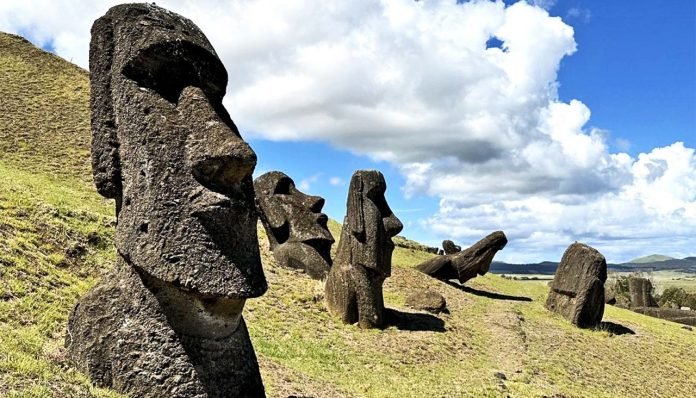
A recent study challenges the popular belief that the ancient inhabitants of Easter Island, known as Rapa Nui, caused their own downfall through environmental destruction.
This new research suggests that the islanders managed to sustain a stable population for centuries, contrary to the long-held idea of a population boom followed by a catastrophic collapse.
Around 800 years ago, Polynesians traveled thousands of miles across the Pacific Ocean to settle on Rapa Nui, one of the most isolated places on Earth.
They created hundreds of giant stone statues, known as “moai,” which stand as iconic symbols of their civilization.
According to the traditional story, the islanders’ population grew too large, leading to deforestation, soil exhaustion, and the collapse of their society.
By the time Europeans arrived in 1722, only a few thousand people remained.
However, a new study published in Science Advances challenges this narrative.
The researchers, led by Terry Hunt from the University of Arizona and Dylan Davis from the Columbia Climate School, argue that the island’s population never grew to unsustainable levels. Instead, the settlers adapted to the island’s limited resources and maintained a stable population through innovative agricultural practices.
The key evidence comes from an advanced analysis of “rock gardens,” where the islanders grew nutritious sweet potatoes, a staple of their diet.
These gardens were designed to maximize limited resources, using rocks to protect plants from wind and salt spray and to retain moisture and nutrients in the soil. The researchers found that the gardens covered enough area to support a few thousand people, not the tens of thousands previously estimated.
Terry Hunt, who has studied Rapa Nui for over 20 years, explains, “Our extensive archaeological research shows that while the ancient islanders faced challenges, they developed clever solutions to sustain their population.” Dylan Davis adds, “The lesson is that the islanders were resilient and modified their environment in sustainable ways.”
Rapa Nui, known for its remoteness, is made of volcanic rock and is located 2,200 miles from central Chile and 3,200 miles from French Polynesia.
The island’s dry climate and steep ocean drop-offs made it challenging for the settlers to harvest marine life and grow crops. To cope, they employed rock gardening, scattering rocks over low-lying areas to create a beneficial microclimate for growing sweet potatoes and taro.
Using data from ground surveys and advanced satellite imagery, the researchers concluded that rock gardens occupy only about 188 acres, less than one-half percent of the island. This supports a population of around 2,000 people if their diet was solely based on sweet potatoes.
However, evidence from bones and teeth suggests that the islanders also relied on marine sources and other crops, raising the population capacity to about 3,000 people, the number observed by Europeans in 1722.
Carl Lipo, an archaeologist at Binghamton University and a coauthor of the study, notes that the idea of a population collapse is losing support among archaeologists.
“Accumulating evidence based on radiocarbon dating does not support the idea of huge populations,” he says. “People’s lifestyle must have been incredibly laborious, involving a lot of manual work to sustain their agriculture.”
Today, Rapa Nui has a population of nearly 8,000 residents and welcomes about 100,000 tourists annually. Most food is imported, but some islanders still use the ancient rock gardens, especially during times of crisis like the COVID-19 pandemic when imports were restricted.
However, modern farming techniques, such as plowing and using artificial fertilizers, may not be sustainable in the long run.
The new study is the latest in a series of findings by Terry Hunt and his colleagues. In 2012, Hunt and Lipo demonstrated how the islanders “walked” the moai statues into place using ropes. In 2019, they discovered that the statues were built near freshwater sources, and in 2020, they found evidence that the islanders continued to maintain their monuments long after Europeans arrived.
Last year, Hunt was among the first to see a newly discovered moai statue at the bottom of a lakebed, sparking new questions about the statues’ use. Hunt continues to research on Rapa Nui, further uncovering the island’s history.
The study, coauthored by Robert DiNapoli of Binghamton University and Gina Pakarati, an independent researcher on Rapa Nui, offers a fresh perspective on the resilience and ingenuity of the island’s ancient inhabitants.



